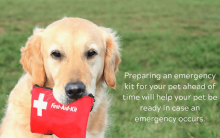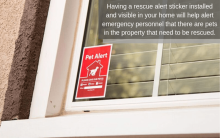By Nicole Abrego
September is National Disaster Preparedness Month. As much as we hope that a natural disaster such as fires, earthquakes, floods, or other events won’t happen near our home, it’s always best to prepare your family in case such an event occurs. Pets are part of your family, and thus, should be included in your family’s emergency plan. Here are some helpful tips on how to make sure that your pet is prepared in case of an emergency.
Prep a Pet Emergency Kit

Having an emergency kit is critical in ensuring that your family is ready for anything that comes your way. Your family’s kit should include necessary supplies such as non-perishable food, plenty of water, first aid kit, and other items needed for your family. The same goes for your pet!
Necessary pet supplies should be included in your family’s emergency kit, or you can create a kit specifically for your pet. This kit should be labeled, easy to travel with, and include the following items:
- Pet’s identification and documents: this includes current ID tags, collars/harnesses, leashes, current paperwork, vaccination records, and your veterinarian’s contact information. It’s helpful to have recent photos of your pet on hand in case your pet becomes lost.
- At least a 2 week’s supply of your pet’s required medication. Mediation should be current and rotated from the kit to ensure it hasn’t expired.
- At least 3 to 7 days worth of canned or dried food (don’t forget to check the expiration on food to provide your pet with fresh food).
- About a week’s worth of bottled water. Water should be rotated every few months so the kit will always contain fresh water.
- Pet feeding and drinking bowls
- Sanitary items such as pet waste bags, pet-safe soap and disinfectant, and garbage bags for clean up. For cats, don’t forget to pack kitty litter and disposable litter trays.
- Pet carrier or crate for transportation of your pet.
- Blankets, toys, and some type of bedding for your pet to lay on.
- Pet first aid kit: This should include items needed in case your pet suffers an injury, such as absorbent gauze pads, adhesive tape, antiseptic wipes, cotton balls, and hydrogen peroxide, just to name a few. You can ask your veterinarian for recommendations on what to include in your pet’s first aid kit.
Install a Rescue Pet sticker
These rescue alert stickers are used to notify rescue personnel that there are animals present in the home and should be placed in a visible location, such as a window or door towards the front of the property. They can be used to list how many animals are in the home as well as the types of animals and their names so emergency personnel will know to rescue these pets in case the property needs to be evacuated. You can request a rescue alert sticker directly from the ASPCA website.
If you happen to evacuate your animals before emergency personnel arrive and if time allows, you can place a note over the sticker or write “EVACUATED” so emergency responders will know your pets are safe with you.

Research Pet Friendly Housing Destinations
Unfortunately, not all emergency housing shelters or hotels allow pets, with the exception in most cases being service animals. It’s imperative that you create a list of safe locations outside the evacuation areas where your pet can be housed in case your home has to be evacuated. You can ask your veterinarian or local shelter for recommended kennels or boarding facilities where your pet can stay in the event that they cannot be taken with you to your emergency housing. You can also ask family members or friends that are outside your immediate area that may be willing to foster your animals while you’re away from your home.
Your list of emergency pet-friendly housing destinations should be written down with full directions and contact information, in case of a natural disaster that may disable internet or cell services.
Having a Designated Caregiver
Choosing a designated caregiver who can temporarily care for your pets in case of an emergency can take some time and consideration on your part. But having a caregiver that can care for your pets if you’re not able to make it to your property during an emergency can really make a difference in your pet’s safety. Your designated caregiver should live nearby and have access to your home, preferably by having access to a house key. They should be someone that you absolutely trust to take care of your pets and your pets should be comfortable around. You can also return the favor and choose to be a designated caregiver for their pets if this person has pets of their own.

Always remember that your pet should never be left behind during an emergency. Pets left on their own can be exposed to many life-threatening dangers and should be evacuated with you and the rest of your family. If you need assistance in setting up a pet emergency plan or need to schedule your pet’s next appointment, contact us today.
The Drake Center for Veterinary Care is an AAHA-accredited animal hospital located in Encinitas, CA. The Drake Center loves being a source of information for all pet owners across the country however if you have any questions regarding pet care and do not live in Encinitas, CA or surrounding cities, we encourage you to contact your local veterinarian.
